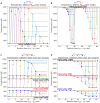Bi-sigmoid spike-timing dependent plasticity learning rule for magnetic tunnel junction-based SNN
- PMID: 38817912
- PMCID: PMC11137280
- DOI: 10.3389/fnins.2024.1387339
Bi-sigmoid spike-timing dependent plasticity learning rule for magnetic tunnel junction-based SNN
Abstract
In this study, we explore spintronic synapses composed of several Magnetic Tunnel Junctions (MTJs), leveraging their attractive characteristics such as endurance, nonvolatility, stochasticity, and energy efficiency for hardware implementation of unsupervised neuromorphic systems. Spiking Neural Networks (SNNs) running on dedicated hardware are suitable for edge computing and IoT devices where continuous online learning and energy efficiency are important characteristics. We focus in this work on synaptic plasticity by conducting comprehensive electrical simulations to optimize the MTJ-based synapse design and find the accurate neuronal pulses that are responsible for the Spike Timing Dependent Plasticity (STDP) behavior. Most proposals in the literature are based on hardware-independent algorithms that require the network to store the spiking history to be able to update the weights accordingly. In this work, we developed a new learning rule, the Bi-Sigmoid STDP (B2STDP), which originates from the physical properties of MTJs. This rule enables immediate synaptic plasticity based on neuronal activity, leveraging in-memory computing. Finally, the integration of this learning approach within an SNN framework leads to a 91.71% accuracy in unsupervised image classification, demonstrating the potential of MTJ-based synapses for effective online learning in hardware-implemented SNNs.
Keywords: MTJ; SNN; STDP; neuromorphic; online learning; spintronics; unsupervised.
Copyright © 2024 Daddinounou and Vatajelu.
Conflict of interest statement
The authors declare that the research was conducted in the absence of any commercial or financial relationships that could be construed as a potential conflict of interest.
Figures







References
-
- Andreeva N., Ryndin E., Gerasimova M. (2020). Memristive logic design of multifunctional spiking neural network with unsupervised learning. Bio. Nano. Sci. 10, 824–833. 10.1007/s12668-020-00778-2 - DOI
-
- Baji T. (2017). “Gpu: the biggest key processor for ai and parallel processing,” in Photomask Japan 2017: XXIV Symposium on Photomask and Next-Generation Lithography Mask Technology (Bellingham, WA: SPIE; ), 24–29.
-
- Caravelli F., Milano G., Ricciardi C., Kuncic Z. (2023). Mean field theory of self-organizing memristive connectomes. Ann. Phys. 535:2300090. 10.1002/andp.202300090 - DOI
LinkOut - more resources
Full Text Sources

